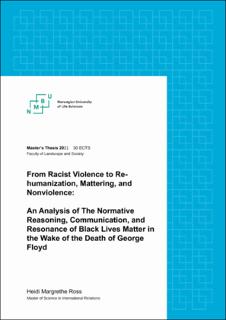| dc.description.abstract | Black Lives Matter (BLM) is a leading force in the struggle for a re-humanization of Black lives. After George Floyd was brutally murdered by a police officer in the summer of 2020, BLM called for the mattering of Black lives and won increasing public support for its protests against the persistent police and state violence that disproportionately affect Black people. The aim of this Master Thesis research was to understand the normative reasoning, communication, and resonance of BLM, with particular attention to how these were evident in the wake of the death of George Floyd. Using a qualitative, grounded theory approach, online sources were analyzed in order to document, interpret and explain the normative views and positions of BLM; to show how these were communicated to advance a re-humanization of Black lives; and to explain how BLM’s thinking and strategy resonated in public discourse, meeting both support and resistance. The analysis and discussion were informed by two closely related perspectives on re-humanization, namely mattering and nonviolence. First, I demonstrate how BLM normative views and positions emphasized the lack of mattering extended to Black lives and opposed the violence that results from, and perpetuates, this unequal mattering. In this way, BLM insisted that an extension of mattering to include Black lives was necessary for re-humanization and racial equality. Further, I show how BLM communicated its demands through social media, direct action, and popular culture. I argue that through these forms of communication, BLM concretized its normative reasoning as the movement 1) embraced the rage that results from unequal mattering and practices of violence that distinguish between lives that matter and lives that do not, and 2) turned this rage into effective, nonviolent action through physically asserting claims to mattering. I explain how BLM thinking, strategy, and messaging evoked support across a broader public discourse than ever before, while also triggering various forms of social and official resistance. I conclude that, through its normative thinking and strategic communication in the aftermath of George Floyd’s death, BLM successfully advanced a re-humanization of Black lives. | en_US |

